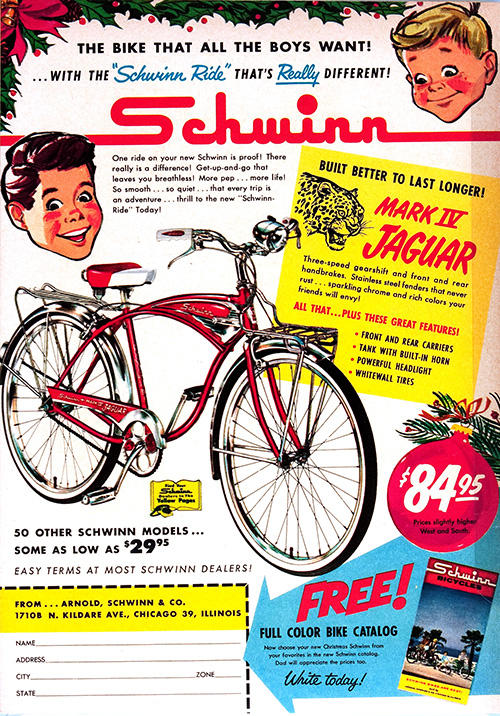
“Schwinn” had a magical name in the 1960s that became synonymous with bicycles. The brand had developed a great reputation for quality and durability.
I was fortunate enough to work in the OEM (Original Equipment Manufacturing) Purchasing Department in this era, which later became the Materials Division.
Everything was done by hand, except for phone calls, and an antiquated pre-dated fax system that actually smoked when a message was sent overseas!
Over the intervening years, the processes and technologies have changed the industry, but in modernizing let’s not lose sight of the key principles every successful business is founded on – quality, collaboration, integrity, and a customer focus.
Ahead of their time with a focus on quality
The company I worked for practiced a strong “Zero Defects” policy for the quality of all components and completed bicycles. This was long before the AQL or Six Sigma quality processes of today.
All bicycles had a lifetime warranty for the frame. We purchased the best bicycle componentry that was available, worldwide, to support our bicycle assembly line.
Today, typical dealers do not have lifetime warrantees on their products. We took pride in quality, and were able to closely manage manufacturing by doing it in-house, and doing checks and double checks before frame completion. Processes were done carefully, by hand, not by machine or robot like the manufacturing world of today.
Today, businesses have replaced top quality with the Six Sigma approach. This means limiting defects to 3.4 or less per million units.
This sounds great, but even operating under Six Sigma, Toyota, GM and other large manufacturers have had significant quality issues.
Is it the different pride and culture of today, or just better business?
Though most larger companies have lost that hands-on touch through automated processes and robotics, closer monitoring, inspection technology and IoT data tracking may help ensure high standards of quality in the future.
Let’s not lose sight of quality products for the sake of more efficient production.
Operating in the true spirit of collaboration
Every supplier in the United States and Europe wanted to do business with our company. We would meet in different cities yearly to collaborate. We invited our overseas and domestic suppliers, dealers and administration to talk about how we could improve, and what the next phase of our business relationship would be.
Collaboration was a key word in the company, long before “synergy” and “strategic alliances” became the buzzwords they are today.
Nowadays, collaboration is coming “alive” again. There is collaboration software, and even competitors are working together to innovate and push industries forward. That was unheard of a generation or two ago.
Back then, we truly partnered with our suppliers. Word of mouth and handshakes “sealed the deal” in the 1960s.
Of course, we used hard copy purchase orders, and there were terms and conditions of doing business on the back side of the P.O. Our suppliers sent their acknowledgments to our P.O.s and they had their own terms and conditions. We called this “the battle of the forms.”
But, it never wound up in court. Back then, if there were ever any issues, we resolved them in the spirit of cooperation and fairness.
Can we bring back this element of cooperation and genuine relationships with our suppliers and distributors?
Integrity and reliability pay off
Schwinn paid on time, every time. Generally, back then the terms were 1%-10-30 and Schwinn took advantage of the 1% discount. If you pay on time and are credible, suppliers wanted that kind of business relationship.
There were some deep negotiations in those days, but there was never any “fists pounding the table” asking for cost reduction. Collaboration and trust resulted in the optimum price per unit of what you purchased. We believed in value, not cheap prices.
The word ‘cheap” is used too much today. It is all about the best price possible. If you do get “cheap”, however, you will also get “cheap” service, quality and delivery. Value is coming back slowly today as consumer demand for “sustainable” products with ethical sourcing increases and supply chain and delivery gets more complex.
We can get the best value out of the supplier/exporter these days by partnering with companies that match our ethics, quality and integrity standards, and not settling for those that will merely give you a better price.
You’ll pay for cost-cutting in these areas in the end, anyway.

Bridging legacy systems with new advances in supply chain technology
During my time with Schwinn, my goal with the suppliers overseas was to meet the delivery date in Chicago, to keep the bicycle assembly line constantly moving. Once the materials were ready, they were given to forwarders of my choice in various countries. We shipped “break bulk”. All parts were put in wooden crates, pre-containerization.
There was no way of tracking these shipments other than by telephone. I would have to give updates to our inventory/production control team if the shipment was needed faster than normal and had to be expedited.
I had a map of the Great Lakes in my office when the lakes were open for vessels. I would mark locations of these vessels daily on the map by calling our broker or forwarder, and inventory/production control could check the map to see where the vessel was at any point.
Contrast that hands-on tracking system to the technology used today. We use an entire array of still emerging technology such as RFID, GPS systems, and software tracking systems to monitor shipments coming from overseas.
The in-transit time shipping “break bulk” from overseas sources was typically six to eight weeks. Yet, the assembly line never stopped.
We did what we had to do to keep our supplies coming in and our products into the hands of our customers.
During an east coast dock strike, I went to Halifax, Nova Scotia, to expedite our crates to keep the bicycle line moving. The crates were everywhere. I worked with the dock workers. I even gave them Canadian cigarettes to keep them motivated.
I looked around and saw large containers and I was curious. I asked, “What are those containers?” The dock workers said the crates were put in containers for ease of use, and for consolidated shipments. They were much easier to work with than wooden crates all over the dock.
Upon return to Chicago, I suggested a containerization program to my boss, the VP of materials. We agreed to a trial shipment.
I alerted my suppliers, forwarders, and customs broker about this new program. We consolidated shipments from our French suppliers and put them in one container.
Once the shipment left France, the container hit Schwinn, Chicago in only three weeks! This was half the time of break bulk shipments. Needless to say, we switched to containers for all of our overseas suppliers in Germany, Switzerland, Italy, and England.
We sold 1,000,000 bicycles in one year and were sold out of production the first day of that new year.
This container program made tracking easier, with less inventory and shorter lead time. Today, 20’ and 40’ containers are standard in overseas purchasing and importing.
Imagine, working with no e-mail, internet, ERP, TMS, WMS, EDI, tracking systems, or iPhone. But, it worked!
Teamwork, quality, a handshake, collaboration, trust and openness was very effective.
Improvements in supply chain management processes, tracking technology, manufacturing and transportation are a great thing. Schwinn was always looking for ways to improve the way things were done.
But in those days taking a hit on quality to make an extra dollar was not an option. And our key focus was always customer satisfaction.
If you can do both, you will always be a success.
Do you think things like collaboration, trust and good old-fashioned handshakes have a place in today’s business world?







disqus comments